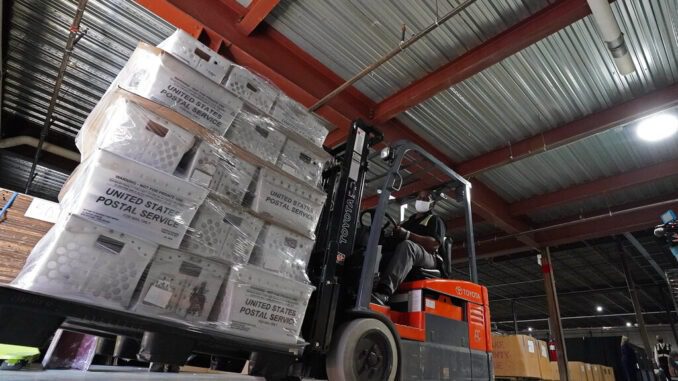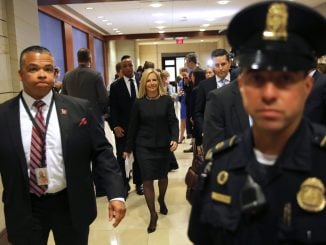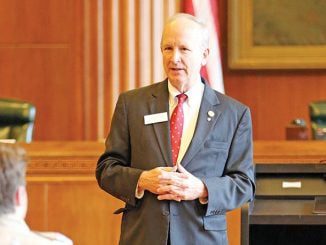
RALEIGH — Weeks from the election, three of North Carolina’s most populous counties are often taking two weeks or more to send absentee ballots out to voters who request them, an Associated Press analysis shows.
Understaffing, outdated technology and voter registration groups are straining a system that has struggled to handle an unprecedented surge of requests as some seek to avoid perceived risks of in-person voting during the coronavirus pandemic.
Data obtained by The AP shows that in Wake County, the state’s largest, it took 15 days on average from when voters requested ballots via mail or an online portal to when the county printed and mailed out ballots during a period from Sept. 1, when the state launched its online portal, through Oct. 5. The analysis only included people who requested a ballot on or after Sept. 1 and excludes ballots that were requested but not yet sent.
Average processing times for Buncombe and Forsyth counties were 14 days and 11 days, respectively, according to the data provided by the State Board of Elections through a public records request.
Many counties’ turnaround times were shorter and have slowly improved, such as Mecklenburg County, the state’s second-largest. It averaged seven days, which matches the average delay statewide.
But the AP analysis shows 10 North Carolina counties are taking more than that seven-day average to process requests. Over 73,000 of the 458,000 people across North Carolina requesting absentee ballots had to wait at least 14 days for their county to get their ballots printed and mailed out.
Slower processing times mean voters have less time to correct any potential errors like missing witness information. The delays could also stifle those who need to request a replacement if a ballot arrives damaged in the mail.
Democrats are especially concerned. They have requested more than twice as many absentee ballots as Republicans statewide.
North Carolina was the first in the nation to begin mailing out absentee ballots to voters on Sept. 4.
The AP examined turnaround times during a crucial period — when statewide ballot requests surged from about 560,000 to nearly 1.2 million. One-fourth of the state’s roughly 1.3 million absentee ballot requests to date have come from three Democratic-heavy counties: Wake, Buncombe and Forsyth.
It was at a Sept. 1 meeting when Corinne Duncan, elections director for Buncombe County, realized she had a staffing problem with only nine full-time employees processing requests.
“We realized how ridiculously tiny that operation was,” Duncan said. “We worked all day long and we processed 1,200 ballots and we realized that that was not going to cut it.”
Over a month, Duncan rushed to find temporary workers and volunteers, with the operation growing to 100 people. Still, more than 6,000 requests remained unfilled out of the nearly 50,000 she said had been received by Thursday.
Duncan said it wasn’t until mid-September that counties were allowed by the state to use batch scanners to process multiple absentee requests. Before that, requests had to be scanned individually.
The deluge of interest in mail-in voting statewide illustrates the challenge for counties. The state had received over 170,000 absentee ballot requests forms by this time in the 2016 presidential election cycle. North Carolina has already surpassed 1.3 million requests this cycle.
Wake County had the longest average processing time in the period examined.
Thomas Abbott, a 31-year-old instructional assistant from Raleigh, waited about three weeks for his ballot. He said he sent a second request, fearing the county didn’t receive his initial request submitted Sept. 9. Records show the county mailed out his ballot Sept. 28.
“I thought that it was our mistake, but it was not,” Abbott said. A registered unaffiliated voter who generally supported Democrats this year, he added: “It’s very surprising to hear that we were so unprepared.”
Gary Sims, director of the Wake County Board of Elections, pinned much of the blame on third-party vendors, such as the left-leaning Center for Voter Information, repeatedly mailing voters ballot request forms. The blank forms appear similar to those provided by counties, causing voter confusion.
“People I know have told me they’ve gotten five, six or eight,” said Gary Sims, director of the Wake County Board of Elections. “People will just fill them out and send them in.”
Absentee request forms arriving by mail take added time to process because elections workers manually enter voters’ information, Sims and Duncan said. If duplicate requests arrive, they need to re-verify the accuracy of the information and compare it to previous requests on file.
Tom Lopach, CEO of the leftist Center for Voter Information, said in a statement that only a small fraction of Wake County voters it tracked submitted multiple absentee ballot requests.
Forsyth County’s top elections official didn’t respond to messages seeking comment.
Other large counties have fared better. In Mecklenburg County, which includes Charlotte, it’s taken seven days on average between a voter requesting a ballot and the county mailing it.
The county’s initial 30-person team processing absentee ballots in September has since increased to 50, said Michael Dickerson, the local elections director.
Use of other government facilities to keep workers socially distant amid the pandemic has sped operations. Soon, he estimated, the county will turn around requests within two days.



